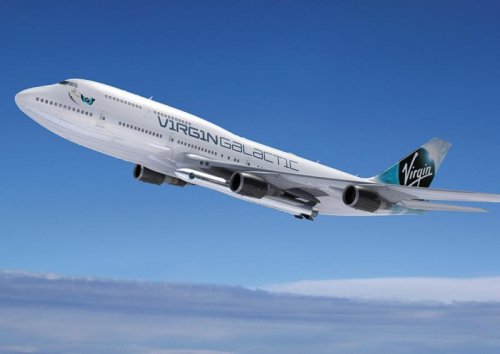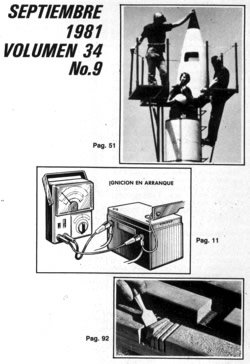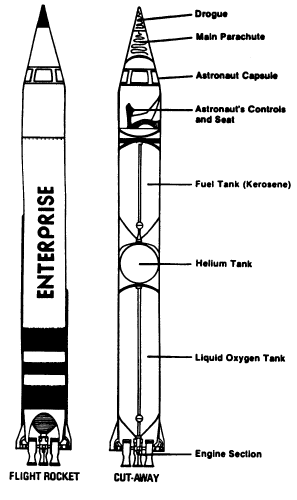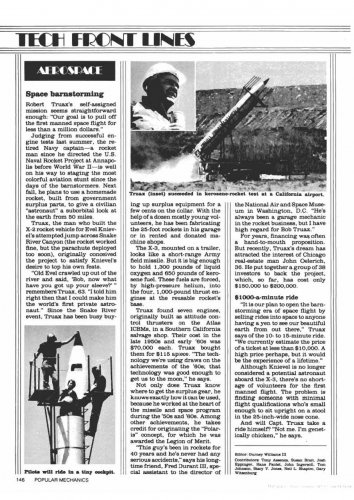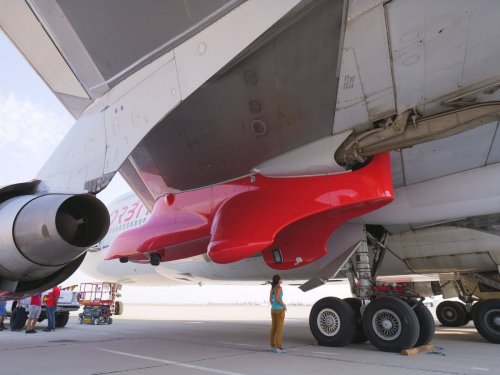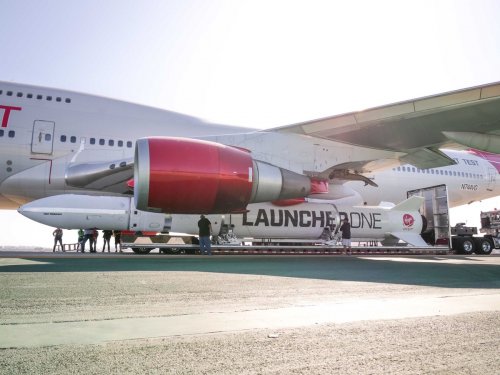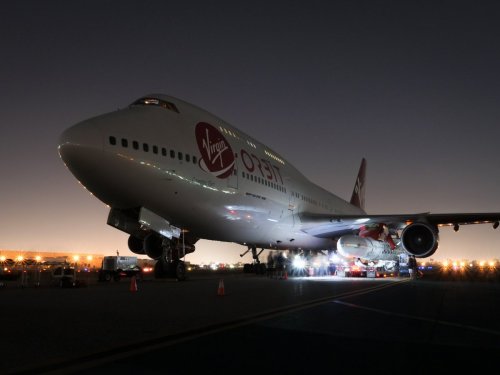You are using an out of date browser. It may not display this or other websites correctly.
You should upgrade or use an alternative browser.
You should upgrade or use an alternative browser.
Virgin Galactic's orbital plans
- Thread starter FutureSpaceTourist
- Start date
-
- Tags
- 21st century
- Joined
- 21 January 2015
- Messages
- 12,156
- Reaction score
- 16,372
Virgin Orbit Readies For Boeing 747 'Cosmic Girl' Flight Test Build-Up
Long Beach -- Virgin Orbit's modified Boeing 747-400 carrier aircraft, Cosmic Girl, is being readied for a series of ground and flight tests in the build-up towards captive carry evaluations of the company’s LauncherOne small satellite launch vehicle. The initial ground test phase will begin in early August and follows delivery of the former Virgin Atlantic Airways 747 to the company's Long Beach, California headquarters on July 31. The aircraft arrived after completing final ...
http://m.aviationweek.com/space/virgin-orbit-readies-boeing-747-cosmic-girl-flight-test-build
Long Beach -- Virgin Orbit's modified Boeing 747-400 carrier aircraft, Cosmic Girl, is being readied for a series of ground and flight tests in the build-up towards captive carry evaluations of the company’s LauncherOne small satellite launch vehicle. The initial ground test phase will begin in early August and follows delivery of the former Virgin Atlantic Airways 747 to the company's Long Beach, California headquarters on July 31. The aircraft arrived after completing final ...
http://m.aviationweek.com/space/virgin-orbit-readies-boeing-747-cosmic-girl-flight-test-build
- Joined
- 21 January 2015
- Messages
- 12,156
- Reaction score
- 16,372
Virgin Orbit - Cosmic Girl Flight Test
Virgin Orbit
Published on Sep 21, 2017
All of our flights to space with LauncherOne will start with our flying launch pad, a Boeing 747-400 named Cosmic Girl. Cosmic Girl is already active in our rigorous flight test program. Recently, our friends at Virgin Galactic captured some fun air-to-air footage of Cosmic Girl in the skies above Mojave. Thanks also to our friends at Virgin Atlantic for taking such great care of Cosmic Girl when she was a baby!
https://www.youtube.com/watch?v=j6O0A8qUgaA
Virgin Orbit
Published on Sep 21, 2017
All of our flights to space with LauncherOne will start with our flying launch pad, a Boeing 747-400 named Cosmic Girl. Cosmic Girl is already active in our rigorous flight test program. Recently, our friends at Virgin Galactic captured some fun air-to-air footage of Cosmic Girl in the skies above Mojave. Thanks also to our friends at Virgin Atlantic for taking such great care of Cosmic Girl when she was a baby!
https://www.youtube.com/watch?v=j6O0A8qUgaA
- Joined
- 21 January 2015
- Messages
- 12,156
- Reaction score
- 16,372
Saudi Arabia investment in our space companies
https://www.virgin.com/richard-branson/saudi-arabia-investment-our-space-companies?amp
Change is happening on a number of fronts in Saudi Arabia. The Crown Prince His Royal Highness Mohammad bin Salman Al-Saud has started to loosen societal restrictions and encourage a more progressive stance on areas such as women’s rights. There have been small steps to date but he is committed to bringing about these modern changes.
At the same time, the Crown Prince is making some bold economic moves as he guides the Kingdom away from its dependence on oil. On Tuesday he announced plans for a $500 billion new city in the north of the Kingdom and today I’m pleased to announce the intention of the Public Investment Fund (PIF) of the Kingdom of Saudi Arabia (KSA), pending approval by the US government, to invest approximately $1 billion into our US based space companies, Virgin Galactic, The Spaceship Company and Virgin Orbit.
This is exciting news for our companies. For our wonderful staff, customers and partners, this investment is a sign of confidence from the international investment community that our vision, our approach and our technology are the right path to commercialising space access. Both VSS Unity and LauncherOne are poised to reach significant technical milestones in the run-up to launch, and we are eager to build out R&D and our US facilities to support next generation vehicles and services.
We are now just months away from Virgin Galactic sending people into space and Virgin Orbit placing satellites around the Earth. This investment will enable us to develop the next generation of human spaceflight, more economic satellite launches and accelerate our programme for trans-continental point-to-point space travel. It also includes the possibility to develop a space-centric entertainment industry in the Kingdom of Saudi Arabia.
We will remain majority shareholders, and our companies will remain firmly rooted in Virgin brand values and based in southern California and New Mexico.
It is also exciting news for the people of Saudi Arabia. As I wrote before, it is time of transformational change in the country’s history thanks to Crown Prince and his bold Vision 2030. The country is putting its oil wealth into growing other sectors such as education, entertainment, tourism, and future forward technology.
Their wish to invest in our space technology is positive progress of the larger societal transformation the Crown Prince seeks to bring to his country and citizens.
We look forward to welcoming KSA as our partners in opening access to space to change the world for good.
https://www.virgin.com/richard-branson/saudi-arabia-investment-our-space-companies?amp
- Joined
- 3 June 2011
- Messages
- 18,339
- Reaction score
- 12,242
blackstar said:Here:
Any idea why they ditched the wing one sees on Pegasus?
- Joined
- 16 April 2008
- Messages
- 9,608
- Reaction score
- 14,504
sferrin said:blackstar said:Here:
Any idea why they ditched the wing one sees on Pegasus?
Might actually be lighter to go with a vectored thrust engine on the first stage, eliminating the need for a wing.
- Joined
- 3 June 2011
- Messages
- 18,339
- Reaction score
- 12,242
TomS said:sferrin said:blackstar said:Here:
Any idea why they ditched the wing one sees on Pegasus?
Might actually be lighter to go with a vectored thrust engine on the first stage, eliminating the need for a wing.
Was that not an option on Pegasus? ???
- Joined
- 16 April 2008
- Messages
- 9,608
- Reaction score
- 14,504
Clearly it was an option, since the second stage uses TVC and is very similar to the first stage in other respects. But they decided in that specific application, the wing was better. I can't find a good reference, but my recollection is that the case for using a wing on Pegasus is fairly marginal. It's possible that newer technology has changed that, or that the launch parameters for the new system are enough different to eliminate the need.
- Joined
- 3 June 2011
- Messages
- 18,339
- Reaction score
- 12,242
TomS said:Clearly it was an option, since the second stage uses TVC and is very similar to the first stage in other respects. But they decided in that specific application, the wing was better. I can't find a good reference, but my recollection is that the case for using a wing on Pegasus is fairly marginal. It's possible that newer technology has changed that, or that the launch parameters for the new system are enough different to eliminate the need.
I just remember at the time Orbital singing praises about the "revolutionary" wing. One would have got the impression that the benefits were pretty significant. (Maybe moreso in the Marketing dept. than in reality?)
Motocar
I really should change my personal text
- Joined
- 16 May 2014
- Messages
- 1,083
- Reaction score
- 1,144
Excuse the off topic ...! A direct predecessor of these initiatives. I am interested in knowing if any of the friends of the forum will have the Popular Mechanis magazine of June 1981 in its English edition (the edition corresponds to the edition in Spanish and was published in September 1981, page 51) in which it was published This article of what looks like the cone of a V2 rocket with a seat
Attachments
Motocar said:Excuse the off topic ...! A direct predecessor of these initiatives. I am interested in knowing if any of the friends of the forum will have the Popular Mechanis magazine of June 1981 in its English edition
https://archive.org/stream/PopularMechanics1981/Popular_Mechanics_06_1981#page/n0/mode/2up
what looks like the cone of a V2 rocket with a seat
Looks like Truax's Volksrocket.
antigravite
ACCESS: Top Secret
- Joined
- 25 April 2008
- Messages
- 836
- Reaction score
- 258
blackstar said:Here:
Hi,
Launching an orbital rocket from a modified B747 has been around for awhile. Among others, back in 2003, this option was under high scrutiny by Rafael, Israel's Armament authority, to propose a responsive minisat launcher, based on their Black Sparrow system.
A.
Motocar
I really should change my personal text
- Joined
- 16 May 2014
- Messages
- 1,083
- Reaction score
- 1,144
Orionblamblam said:Motocar said:Excuse the off topic ...! A direct predecessor of these initiatives. I am interested in knowing if any of the friends of the forum will have the Popular Mechanis magazine of June 1981 in its English edition
https://archive.org/stream/PopularMechanics1981/Popular_Mechanics_06_1981#page/n0/mode/2up
what looks like the cone of a V2 rocket with a seat
Looks like Truax's Volksrocket.
Uppss...! Published in Popular Mechanics March 1981 page 146
https://youtu.be/jXp1fqahg1Q
https://youtu.be/dS3ht4EZRmM
Attachments
Motocar
I really should change my personal text
- Joined
- 16 May 2014
- Messages
- 1,083
- Reaction score
- 1,144
- Joined
- 26 September 2008
- Messages
- 1,960
- Reaction score
- 746
antigravite said:Launching an orbital rocket from a modified B747 has been around for awhile. Among others, back in 2003, this option was under high scrutiny by Rafael, Israel's Armament authority, to propose a responsive minisat launcher, based on their Black Sparrow system.
I would bet it goes back a lot farther. Did Orbital ever consider it for the Pegasus back in the 1980s or did they go straight to the L-1011? One downside of airliners is that they have wings mounted at the bottom of the fuselage, limiting the size of the load. The Air Launched Sortie Vehicle proposal of the early 1980s would have mounted a rocket atop a 747. Transport planes like the C-5 with a high-mounted wing have advantages. There have been other, more recent proposals for mounting the rocket on top of the 747.
Air-launch is just less attractive than you'd think. Intuitively it seems like a good idea, but the disadvantages eat away at the few advantages. For example, will Virgin Galactic save enough money by using a 747 considering that it burns fuel, requires maintenance, and has other costs like certification? Granted, Virgin Airlines operates other 747s and can spread out some of that cost because this one will simply be part of a fleet, not a one-off vehicle. But it remains to be seen how competitive they'll be.
- Joined
- 16 April 2008
- Messages
- 9,608
- Reaction score
- 14,504
blackstar said:I would bet it goes back a lot farther. Did Orbital ever consider it for the Pegasus back in the 1980s or did they go straight to the L-1011? One downside of airliners is that they have wings mounted at the bottom of the fuselage, limiting the size of the load. The Air Launched Sortie Vehicle proposal of the early 1980s would have mounted a rocket atop a 747. Transport planes like the C-5 with a high-mounted wing have advantages. There have been other, more recent proposals for mounting the rocket on top of the 747.
The 747 was one of the options studied in 1991, when they opted for an L1011. The other main options were the DC-10 and a B-52G (I imagine there would be treaty issues with a commercially owned B-52!).
The analysis of alternatives is mentioned briefly in the following report.
http://digitalcommons.usu.edu/cgi/viewcontent.cgi?article=2684&context=smallsat
antigravite
ACCESS: Top Secret
- Joined
- 25 April 2008
- Messages
- 836
- Reaction score
- 258
TomS said:blackstar said:I would bet it goes back a lot farther. Did Orbital ever consider it for the Pegasus back in the 1980s or did they go straight to the L-1011? One downside of airliners is that they have wings mounted at the bottom of the fuselage, limiting the size of the load. The Air Launched Sortie Vehicle proposal of the early 1980s would have mounted a rocket atop a 747. Transport planes like the C-5 with a high-mounted wing have advantages. There have been other, more recent proposals for mounting the rocket on top of the 747.
The 747 was one of the options studied in 1991, when they opted for an L1011. The other main options were the DC-10 and a B-52G (I imagine there would be treaty issues with a commercially owned B-52!).
The analysis of alternatives is mentioned briefly in the following report.
http://digitalcommons.usu.edu/cgi/viewcontent.cgi?article=2684&context=smallsat
wow thx!
A.
Launch at mid year if no hiccups or money shortages. Main financial backer is government of Abu Dhabi.
https://www.youtube.com/watch?v=5YV7ZsoaLo4
Newtron 3 is main stage engine producing 75,000lbs thrust.
https://www.youtube.com/watch?v=epIB4cqKDT4
Newtron 4 is 2nd stage engine producing 5,000lbs thrust.
https://www.youtube.com/watch?v=eYImjgBF2oM
Fairing test
https://www.youtube.com/watch?v=ONv98FWW1hM
https://www.youtube.com/watch?v=5YV7ZsoaLo4
Newtron 3 is main stage engine producing 75,000lbs thrust.
https://www.youtube.com/watch?v=epIB4cqKDT4
Newtron 4 is 2nd stage engine producing 5,000lbs thrust.
https://www.youtube.com/watch?v=eYImjgBF2oM
Fairing test
https://www.youtube.com/watch?v=ONv98FWW1hM
- Joined
- 13 August 2007
- Messages
- 8,451
- Reaction score
- 11,025
I have only one question
In October is 14 years ago that Space Ship One flew first time
Were is Space Ship Two commercial flights ?
In October is 14 years ago that Space Ship One flew first time
Were is Space Ship Two commercial flights ?
Silencer1
That now I am the Ruler of the Queen's Navee!
- Joined
- 3 August 2009
- Messages
- 897
- Reaction score
- 582
Michel Van said:I have only one question
In October is 14 years ago that Space Ship One flew first time
Were is Space Ship Two commercial flights ?
Just ask Elon Musk!
More seriously, it's a good question.
Looks, like unlike of SpaceX, Virgin didn't so clearly seen the future and their own possibilities. Instead of targeting rich persons, which want to be short-time space tourists, more money comes from the conquering of world's satellite launch market. Who could imagine, that private company could do successful, frequent, reliable launches by it's own rocket? Not me
From other hand, the appearance of private space companies decades ago have been a trend, that continues now. Some of them succeed, some - not.
Curiously, I remember another Virgin's cool design - Virgin Oceanic submarine. Very promising, and stopped in development. Of course, it has been a real engineering challenge, but without success.
Musk is far, far more serious than Branson. Branson is a good car salesman, but as far as engineering goes, he is a total loss. Branson likes partying, alcohol, drugs, chicks, and hype, and giant adds for Virgin.
- Joined
- 13 August 2007
- Messages
- 8,451
- Reaction score
- 11,025
Archibald said:Musk is far, far more serious than Branson. Branson is a good car salesman, but as far as engineering goes, he is a total loss. Branson likes partying, alcohol, drugs, chicks, and hype, and giant adds for Virgin.
Next to that Branson enjoy record-breaking attempts or guest starred in Movies or TV series, Game shows, usually playing himself...
...one moment Musk and serious ?
First Day at SpaceX

https://www.youtube.com/watch?v=lCKRGfqeaBg
oh by way...
https://www.youtube.com/watch?v=4CsQLIMXMI4
- Joined
- 21 January 2015
- Messages
- 12,156
- Reaction score
- 16,372
Virgin Orbit ready LauncherOne rocket for maiden flight
https://www.nasaspaceflight.com/2018/06/virgin-orbit-launcherone-maiden-flight/
Virgin Orbit is just months away from the first launch of its LauncherOne rocket. The company is currently undergoing an extensive test campaign to ensure that the vehicle will function correctly on its maiden flight.
https://www.nasaspaceflight.com/2018/06/virgin-orbit-launcherone-maiden-flight/
- Joined
- 21 January 2015
- Messages
- 12,156
- Reaction score
- 16,372
Virgin Orbit wins FAA license for first LauncherOne mission
http://spacenews.com/virgin-orbit-wins-faa-license-for-first-launcherone-mission/
Virgin Orbit has received a license from the Federal Aviation Administration for the first launch of its LauncherOne vehicle, which the company hopes to perform later this summer.
The FAA issued the license June 29 for the first launch of the air-launch system, using the LauncherOne rocket flown from a customized Boeing 747 that takes off from Mojave Air and Space Port in California. The payload for that launch is identified as a “mass simulator with CubeSat,” but doesn’t specify the identity of the cubesat or cubesats that will fly on the mission.
The FAA license is for a reusable launch vehicle (RLV), even though LauncherOne itself is expendable. The Boeing 747 used as the launch platform is reused, but Northrop Grumman’s Pegasus rocket, which is also an air-launched system, is licensed as an expendable launch vehicle by the FAA.
http://spacenews.com/virgin-orbit-wins-faa-license-for-first-launcherone-mission/
- Joined
- 21 January 2015
- Messages
- 12,156
- Reaction score
- 16,372
Virgin Orbit performs LauncherOne aircraft flight tests
https://spacenews.com/virgin-orbit-performs-launcherone-aircraft-flight-tests/
The carrier aircraft for Virgin Orbit’s LauncherOne system has performed a series of test flights in preparation for upcoming flights with the rocket attached.
The flights of the company’s Boeing 747 aircraft, nicknamed “Cosmic Girl,” were the first since the company installed a pylon on the plane’s left wing that will be used to carry the LauncherOne rocket on future flights of the air-launch system.
https://spacenews.com/virgin-orbit-performs-launcherone-aircraft-flight-tests/
NUSNA_Moebius
I really should change my personal text
- Joined
- 26 May 2012
- Messages
- 233
- Reaction score
- 136
Takes advantage of the spare engine mount structure right?
- Joined
- 27 May 2008
- Messages
- 1,179
- Reaction score
- 2,485
Yes - it’s on the same hard point.
The tyres right next to a thin skin lox tank.....oh dear. How will they ever cert that considering the accepted
probability of a wheel/tire failure? It won’t even come close to normal standards for an acceptable total aircraft loss model.
Without a rocket in the tire debris zone, it’s a considerable effort to justify the wheel and tyre failure certification criteria.... and it normally dictates the location of key equipment required to maintain safe flight outside of the debris zone.
The tyres right next to a thin skin lox tank.....oh dear. How will they ever cert that considering the accepted
probability of a wheel/tire failure? It won’t even come close to normal standards for an acceptable total aircraft loss model.
Without a rocket in the tire debris zone, it’s a considerable effort to justify the wheel and tyre failure certification criteria.... and it normally dictates the location of key equipment required to maintain safe flight outside of the debris zone.
antigravite
ACCESS: Top Secret
- Joined
- 25 April 2008
- Messages
- 836
- Reaction score
- 258
More pictures here:
https://www.space.com/16532-virgin-galactic-launcherone-rocket-images.html
A.
https://www.space.com/16532-virgin-galactic-launcherone-rocket-images.html
A.
- Joined
- 21 January 2015
- Messages
- 12,156
- Reaction score
- 16,372
Virgin Orbit's LauncherOne Rocket Mated to 'Cosmic Girl'
VideoFromSpace
Published on Oct 26, 2018
On Oct. 24, 2018, Virgin Orbit's LauncherOne rocket was mated to its 'Cosmic Girl' carrier plane for the first time. The rocket can carry a 300 pound (660 kg) satellite into Sun-synchronous orbit at speeds over 17,500 mph.
https://www.youtube.com/watch?v=7R4w4FTLtAA
VideoFromSpace
Published on Oct 26, 2018
On Oct. 24, 2018, Virgin Orbit's LauncherOne rocket was mated to its 'Cosmic Girl' carrier plane for the first time. The rocket can carry a 300 pound (660 kg) satellite into Sun-synchronous orbit at speeds over 17,500 mph.
https://www.youtube.com/watch?v=7R4w4FTLtAA
- Joined
- 21 January 2015
- Messages
- 12,156
- Reaction score
- 16,372
Virgin Orbit - First Captive Carry Flight
Virgin Orbit
Published on Nov 19, 2018
On November 18th, 2018, a new sight appeared in the baby-blue skies over Southern California: A specially modified 747-400 carrying a 70-foot-long rocket under its wing soared through the air as part of a successful test flight for Virgin Orbit’s LauncherOne. Sir Richard Branson’s small satellite launch company completed a flawless test flight, proving that its carbon-fiber two-stage rocket works perfectly as a pair with Cosmic Girl, the customized former passenger aircraft that serves as the company’s “flying launch pad.” The successful test puts more air under the wings—and fins—of the company’s plans to reach orbit in early 2019.
https://www.youtube.com/watch?v=w7Z8nDShFes
Virgin Orbit
Published on Nov 19, 2018
On November 18th, 2018, a new sight appeared in the baby-blue skies over Southern California: A specially modified 747-400 carrying a 70-foot-long rocket under its wing soared through the air as part of a successful test flight for Virgin Orbit’s LauncherOne. Sir Richard Branson’s small satellite launch company completed a flawless test flight, proving that its carbon-fiber two-stage rocket works perfectly as a pair with Cosmic Girl, the customized former passenger aircraft that serves as the company’s “flying launch pad.” The successful test puts more air under the wings—and fins—of the company’s plans to reach orbit in early 2019.
https://www.youtube.com/watch?v=w7Z8nDShFes
FighterJock
ACCESS: Above Top Secret
- Joined
- 29 October 2007
- Messages
- 5,609
- Reaction score
- 5,941
The Virgin Galactic plane has pushed the Unity spaceplane (can we call Unity a spaceplane?) higher and faster than the last flights flying at over 90,000 feet before gliding back to Earth.
https://www.bbc.co.uk/news/science-environment-47336617
https://www.bbc.co.uk/news/science-environment-47336617
FighterJock
ACCESS: Above Top Secret
- Joined
- 29 October 2007
- Messages
- 5,609
- Reaction score
- 5,941
sferrin said:90 km not 90k feet.
Oops, my mistake, that is what happens when you type fast. Thanks sferrin.
- Joined
- 21 January 2015
- Messages
- 12,156
- Reaction score
- 16,372
Video on the link below.
https://twitter.com/virgin_orbit/status/1107713439206563840
https://twitter.com/virgin_orbit/status/1107713439206563840
LauncherOne's first stage lit up our Mojave test site on Friday for the first hot-fire in our final series of full-scale, integrated system tests.
Similar threads
-
-
-
-
SNC Chosen by DOD to Design, Develop Unmanned Orbital Outpost Prototype
- Started by Flyaway
- Replies: 6
-
SKYRORA - UK return to Space - This time it's Private
- Started by Michel Van
- Replies: 53


